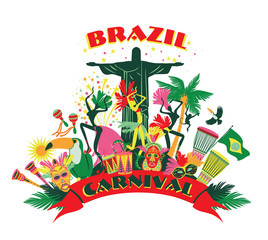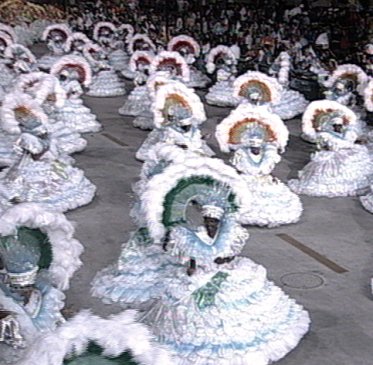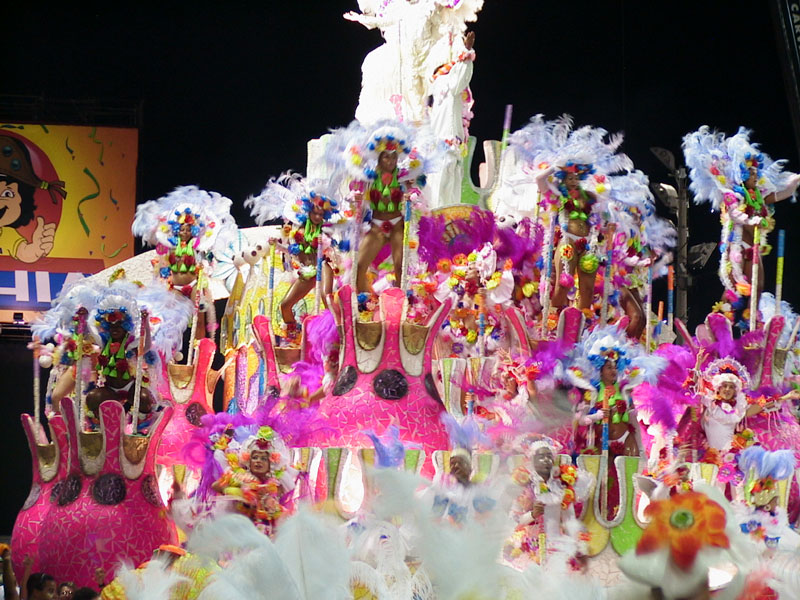 The Carnival of Brazil is an annual festival in Brazil held forty days before Easter. Carnival is the most famous holiday in Brazil. It is not about a big moment in history or about a famous person, but it is important for the people because it's a time of camaraderie, freedom, and almost a whole week without work. People can choose between parties or rest, and most people choose parties, day after day, night after night.
The Carnival of Brazil is an annual festival in Brazil held forty days before Easter. Carnival is the most famous holiday in Brazil. It is not about a big moment in history or about a famous person, but it is important for the people because it's a time of camaraderie, freedom, and almost a whole week without work. People can choose between parties or rest, and most people choose parties, day after day, night after night.
Brazilian Carnival exhibits some differences from its European counterparts, having mixed European, African, and Native elements. Furthermore, rhythm, participation, and costume vary from one region of Brazil to another.
The south-eastern cities of Rio de Janeiro and São Paulo organize parades led by samba schools vie for prizes on the "sambodromo" open stage. Only samba-school affiliates participate in the shows. Smaller cities often have no public events, but promote balls in recreational clubs.
The north-eastern cities of Salvador and Recife organize groups parading through streets, but watchers are also welcome to dance.
Rio de Janeiro Carnival
Modern Brazilian Carnival originated in Rio de Janeiro in 1641, when the city's bourgeoisie imported the practice of holding balls and masquerade parties from Paris. It originally mimicked the European form of the festival, later absorbing and creolizing elements derived from Native American and African cultures.

In the late 19th century, the cordões (literally laces or strings in Portuguese) were introduced in Rio de Janeiro. These were pageant groups that paraded through city avenues performing on instruments and dancing. Today they are known as Blocos (blocks), consisting of a group of people who dress in costumes or special t-shirts with themes and/or logos. Blocos are generally associated with particular neighborhoods; they include both a percussion or music group and an entourage of revellers.

Block parades have become an expressive feature of Rio's Carnival. Today, they number more than 100 and the groups increase each year. Blocos can be formed by small or large groups of revelers with a distinct title with a often funny pun. They may also note their neighborhood or social status. Before the show, they gather in a square, then parade in sections of the city, often near the beach. Some blocos never leave one street and have a particular place, such as a bar, to attract viewers. Bloc parades start in January, and may last until the Sunday after Carnival.
Blocos parade in nearly every neighborhood, but the most famous ones parade in Copacabana, Ipanema, Leblon, Lagoa, Jardim Botânico, and in downtown Rio. Organizers often compose their own music themes that are added to the performance and singing of classic "marchinhas" and samba popular songs. "Cordão do bola preta" ("Polka Dot Bloco"), that goes through the heart of Rio's historical center, and "Suvaco do Cristo" (Christ's statue armpit, referring to the angle of the statue seen from the neighborhood), near the Botanical Garden, are some of the most famous groups. Monobloco has become so famous that it plays all year round at parties and small concerts.

Samba schools are very large groups of performers, financed by respected organizations (as well as illegal gambling groups), who work year round in preparation for Carnival. Samba Schools perform in the Sambadrome, which runs four entire nights. They are part of an official competition, divided into seven divisions, in which a single school is declared the winner, according to costume, flow, theme, and band music quality and performance. Some samba schools also hold street parties in their neighborhoods, through which they parade along with their followers.
Carnival is a multicoloured parade of the Samba Schools. Official is it a removal of two days, but in general takes the festival longer. People from all over the world are dancing around the parade floats. The motto of the carnival is “Everyone is free”. There are 14 Samba Schools. All of them act out with 3.000 to 5.000 members (singers and dancers) to make a parade of 82 minutes. On both days act out in each case 7 Samba Schools. On Ash Wednesday is the counting of the scores. The counting is shown in all TV-channels in Brazil. The celebration of the winners is celebrated with fireworks.

- Preparations Underway for Brazil's Carnival with comments on each photo from the Washington Post:
- MSNBC has a slideshow about Rio de Janiero and its Carnival:
- A photogallery from WA Today:
